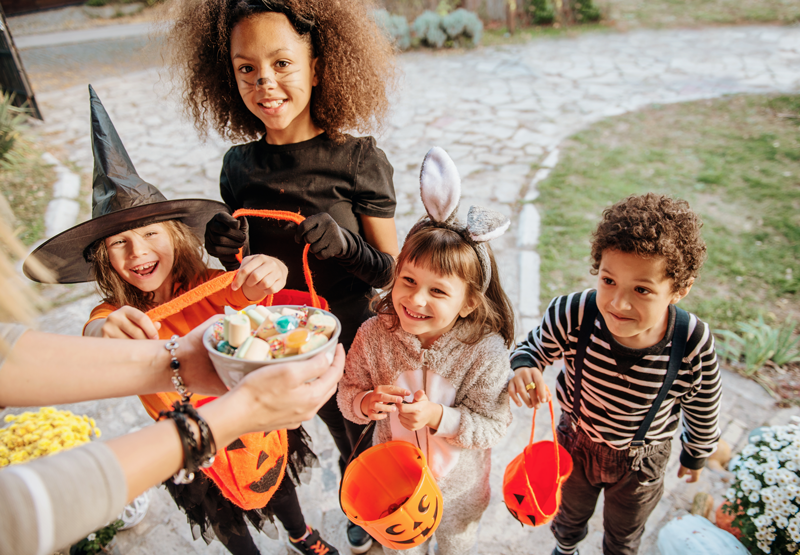The eerie, ancient origins of Halloween
October 16, 2022
by Lindsey Flannery

Nothing sets the Halloween mood quite like placing a glowing jack-o-lantern on the front porch, dressing up in an elaborate costume, or going trick-or-treating. We’ve come to love these Halloween traditions, but where did they come from?
Diving into the history of Halloween reveals ancient rituals, freaky folktales and old-world traditions that together tell an eerie tale about the origins of this beloved holiday.
Samhain & pagan rituals
The roots of Halloween are found across ancient pagan traditions, in festivals that celebrate the final harvest and the entrance into the dark half of the year. This occurs at the halfway point between the autumn equinox and the winter solstice, around October 31-November 1.
The most well-known of these ancient festivals is Samhain, pronounced SOH-win, celebrated by ancient Celts around 2,000 years ago in what is now Ireland. Like many pagan traditions, Celts viewed time as cyclical. Samhain was the last and most important of the four “cross-quarter” days, which each mark the halfway point between an equinox and solstice.
Samhain was the most powerful liminal, or transitional, time between the light and darkness, between summer and winter. The Celts believed that at this time, the veil between the living and the dead was at its thinnest, and the dead could walk among the living.1
At Samhain, the ancient Celts would put out their hearth fires and go about gathering the last of the harvest from the fields. Then, they would gather at large campfires built by the druids (members of a high-ranking class of religious leaders), bringing harvest food and sacrificed animals to share at a communal dinner. Afterwards, they’d use the communal fire to relight the fires in their own homes to help protect them and keep them warm during the winter.2
The origin of Halloween costumes & jack-o-lanterns
Because the veil was thin at Samhain, the Celts mostly stayed indoors with candles and hearth fires lit to ward against unwanted energies, but others felt safe enough to walk around the village if they wore nightmarish costumes that fooled evil spirits into thinking they were kin. This is why the ancient Druids attended the Samhain bonfires dressed in animal hides.1
Another way the Celtic villagers warded off restless souls was to carve evil-looking faces into root vegetables such as turnips, beets and potatoes, which were abundant from the harvest. These carved root vegetables also served a functional purpose, as they would hollow them out and place a burning ember inside, and use them as lanterns.5
The term “jack-o-lantern” has its origins in an 18th-century Irish folktale of Stingy Jack, a blacksmith who caused mischief. The story goes that Stingy Jack tricked the devil twice, and was barred from both heaven and hell when he died. The devil took pity on Jack and gave him an ember of coal to light his turnip lantern, which he carried back and forth as he wandered between heaven and hell for eternity. He became known as Jack-of-the-Lantern, or jack-o’-lantern.5
Ritual origins of Trick-or-Treating
Because Samhain and related pagan celebrations were a time to honor the dead, a ritual called “souling” arose. Poor people would visit the homes of wealthier families and receive pastries called “soul cakes” in exchange for praying for the souls of the homeowners’ dead relatives.4 This led to children going door to door asking for gifts of food and money.
In Ireland and Scotland, young people took part in another tradition that more closely resembles modern-day trick-or-treating, called “guising.” They would dress up in costume and sing a song, tell a joke or recite a poem at various households in exchange for a treat of coins, fruit or nuts.4
A similar tradition existed in the middle ages called “mumming,” in which people dressed as demons and ghosts and performed antics in exchange for food and drink. This is thought to be another predecessor of modern-day trick-or-treating.
Modern-day Halloween is born – slowly
The influence of Christianity made it to Celtic lands by the 9th century, and the Church had established November 1st as All Saint’s Day and November 2nd as all Soul’s Day, days to honor the dead.3 Today it’s generally believed that the church aimed to replace Samhain with a church-sanctioned holiday with similar traditions, as it did with other holidays like Easter and Christmas.
The All Saints’ Day celebration was also called All-Hallows In England, and so the night before, the traditional night of Samhain celebrations, became known as “All-Hallows Eve.” These holidays eventually morphed into the modern-day Halloween, especially in the mid-1800s as Irish people fleeing the potato famine brought their old-world traditions like guising and gourd carving to the U.S.
So Halloween, like most holidays that we celebrate in the U.S., has its roots in paganism, or earth-based religions in which people honored the cycles of the seasons, of the earth, and of life and death.
As you’re carving your pumpkins and donning your costumes this year, let this knowledge of the ancient origins of the holiday imbue your celebrations with new meaning.
References
- Kiernan, A., & Olson, L. (2021). The Ultimate Guide to the Witch's Wheel of the Year: Rituals, Spells & Practices for Magical Sabbats, Holidays & Celebrations. Fair Winds.
- https://www.bbc.co.uk/religion/religions/paganism/holydays/samhain.shtml
- https://www.history.com/news/halloween-timeline
- https://www.history.com/news/halloween-trick-or-treating-origins
- https://www.nationalgeographic.com/travel/article/the-twisted-transatlantic-tale-of-american-jack-o-lanterns
